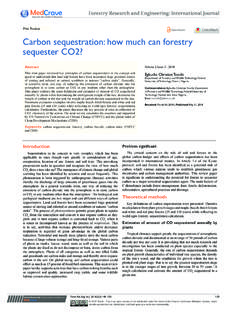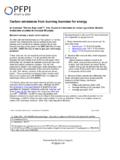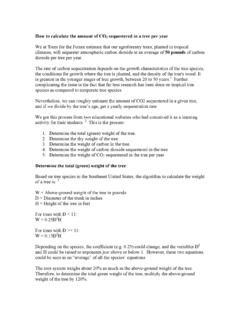Transcription of Measuring soil carbon change
1 Measuring soil carbon changePeter Donovanversion: October 2013 This guide can be freely copied and adapted,with attribution, no commercial use, andderivative works similarly this guide is about,and how to use itiv1 The work of the .. carbon cycle.. , not make.. : a strategic and creative choice..42 Measuring soil , result, and uncertainty .. and inorganic soil carbon .. tests .. started ..143 Site selection and sampling your site .. plots .. tools .. intensity within the plot..174 Sampling and field out a transect and mark the plot center .. surface observations .. out the plot .. probe to take samples .. with abundant rocks, gravel, or coarse fragments .. the soil .. the sample .. deeper .. for bulk density.
2 Resampling .. Correcting for changes in bulk density ..29ii5 Getting your samples preparation .. samples .. sampling to test your lab .. labs that do elemental analysis or dry combustion test .. calculations .. gas emissions .. entry and mapping .. soil carbon Challenge ..357 Forms and equipment .. plan .. checklist .. data form ..398 Signal vs. noise (statistics) and probability .. error .. of variation .. paired samples .. sampling.. with statistics ..499 References52 Notes55 Index56 What this guide is about,and how to use itDo civilizations fall because the soil fails to produce or does asoil fail only when the people living on it no longer know how tomanage their civilization?Charles Kellogg, soil and Society This short guide is for people who are interested in the possibilities of turning atmo-spheric carbon into soil carbon .
3 It is about gauging fundamental biosphere function atspecific locations. It is about monitoring: why, how, and previous writings on the subject have treated the measurement of soil carbonprimarily as a technical issue, requiring a high level of knowledge and expertise, and werefocused on verifying greenhouse gas offsets or selling carbon credits, either in existingor anticipated guide is carbon measurement is as much a social issue, involvingbeliefs and attitudes, as it is a technical one. This guide does not offer approved methodsfor verifying greenhouse gas offsets. Nor does it contain specific advice about whichagricultural practices, technologies, or species might be best at building carbon in thesoil, or predictions about the global effects of such practices.
4 However, the monitoringpractices outlined in this guide will be useful in developing site-specific answers to are many contexts and ways of thinking about soil carbon , and differentperceptions on its importance. How you measure something depends on your purpose,and this guide aims to accommodate a spectrum of purposes. Are you wanting to knowif your lawn, farm, or ranch is turning atmospheric carbon dioxide into water-holding,fertility-enhancing soil organic matter, or the reverse? Are you wanting to show what spossible with management? Are you trying to convince yourself, or others, that thechanges you are working toward with your land management are having an impact onsoil carbon ?Much of world agriculture has long depended on purchased inputs of nitrogen, potas-sium, and phosphorus.
5 carbon , the principal dry-weight constituent of crop residueand manure, has typically been regarded as a waste product and a disposal problem, tobe dumped somewhere else, or and more people have been pointing out that soil carbon sequestration couldoffset fossil fuel emissions, with plenty of other benefits besides. It s no surprise thativthere s resistance, power struggles, and confusion around the increasing emphasis onsoil carbon . There has been lots of research and prediction, but very little in the way ofmonitoring local changes over time, and relatively little change in agricultural incentivesor and agricultural experts have been saying that soil carbon is too hard ortoo expensive to measure because of its variability and complexity, and that the onlypractical way to get a handle on what is happening with carbon in soils, or to design theproper incentives, is computer modeling based on standardized agricultural practices,aided by remote guide aims at a different approach, which has been developed for the soil CarbonChallenge (see page 35).
6 Variability and complexity are not the enemy, but the rawmaterials for creativity and innovation, for enhancing biosphere functions and lettingthe solar-powered plants, microbes, and animals do more of the guide attempts to cut through some of the confusion and technical trappingsthat have accumulated around the subject of soil carbon , soil carbon change , and itsmeasurement. It attempts to provide a monitoring method that is both flexible thatcan be adapted to a variety of purposes and situations and on your purpose, Measuring change in soil carbon need not be difficult,and it need not cost much. The methods described here will enable you to measurechange in soil carbon with accuracy and confidence, using hand tools and establishedlaboratories for accurate soil analysis.
7 For a quick overview of what is involved, take alook at the checklist on page if you don t want to measure soil carbon change yourself, this guide will help youunderstand the process and some of what is at developing this guide (an ongoing process) I am indebted to many dedicated andhardworking people, who have both taught me some possibilities about Measuring soilcarbon, and have helped me understand the questions, methods, possibilities, contexts,and limitations both of the soil carbon opportunity, and in our ways of thinking addition, the approach and methods advocated here owe much to previouspublications, such as Ellert, Janzen, and Entz 2002, and most of which are listed in work of the biosphereLife is the most powerful geologic VernadskyIn the 1920s, the Russian geochemist Vernadsky recognized that the composition of theatmosphere results from the metabolisms and choices of the biosphere s self-motivatedand autonomous organisms, from bacteria to the time.
8 There was little demand for this kind of understanding. But it is increas-ingly obvious that the decline in biosphere function worldwide is accelerating. Thecomposition of the atmosphere is changing, with reduced transparency to the radiationof heat into space. With atmospheric change comes increasing acidity in the will try to preserve the problem to which they arethe ShirkyThough we may recognize our dependence on the biosphere, we tend to view it as asomewhat static environment, vulnerable to our greed and technology, in need of pro-tection. The problem-solving environmentalism of the last two generations has workedon protecting nature from harm and pollution: regulating, limiting, and changing it s not working very well.
9 Even ceasing to burn fossil fuels altogether won t solvethe atmospheric carbon biosphere is the sum of all the living and the dead. It doesn t just sit there lookingpretty, wild, or vulnerable. It does work, a lot of it. In addition to the enormous depositsof fossil fuels whose oxidation currently powers our civilization, the biosphere s r esum eincludes the calcium carbonate rocks that cover a tenth of the earth s surface, bandediron ore formations that supply our steel, much of ocean chemistry, soils that feed theworld, peat formations, and the composition of the atmosphere. Current responsibilities1 Measuring soil carbon change : A flexible, practical, local method2include feeding everybody, capturing and holding soil moisture for land dwellers, and allthe rest of what are called ecosystem issue is not just technology, though it plays a large role.
10 The issue is that, over vastareas of the world,the biosphere is not doing enough livestock confined,and crop monocultures dependent on fossil energy to maintain them, too many ofthe animals are in prison, too many of the plants are on welfare, and too many of themicrobes are is force over distance, getting things done. Most of the biosphere s work is donethrough the chemistry of photosynthesis. Solar powered, this work converts inert carbondioxide into food for all carbon cycleHumus plays a leading part in the storage of energy of solarorigin on the surface of the Waksman, 1936 The pattern and process of this work is the carbon cycle. carbon is life and food, andmoves from atmosphere to plants and soils and back in a grand cycle that is sometimescalled the circle of life.








